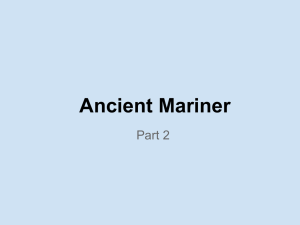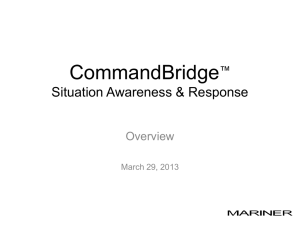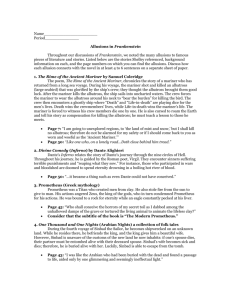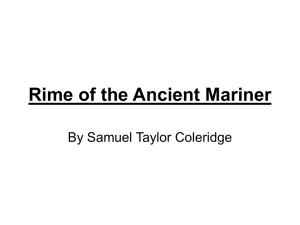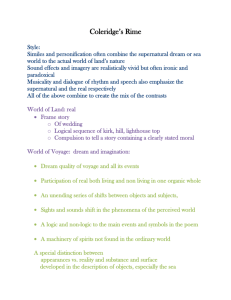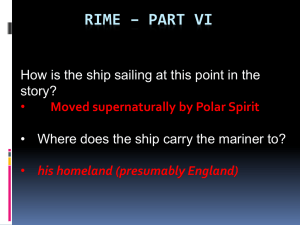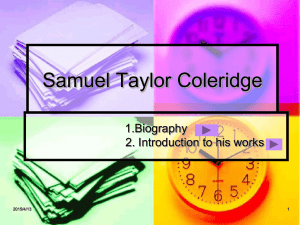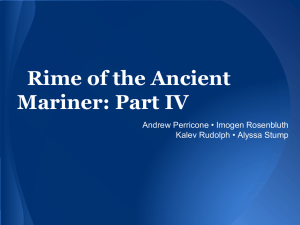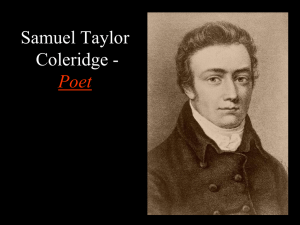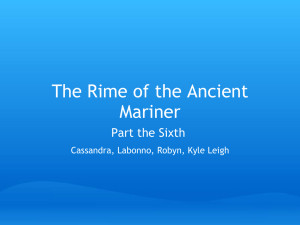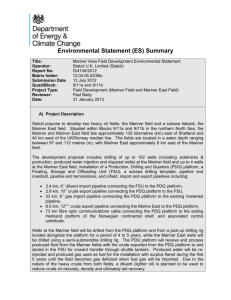The Rime of the Ancient Mariner: Part II
advertisement
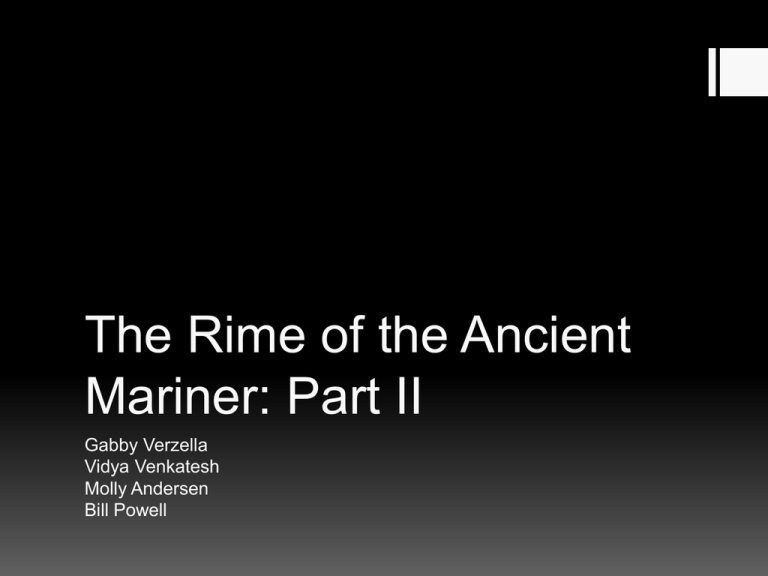
The Rime of the Ancient Mariner: Part II Gabby Verzella Vidya Venkatesh Molly Andersen Bill Powell • • • • • • • Contrast to beginning description of voyage: heading homewards Negative imagery despite escape from ice Parallel drawn between the Albatross, the wind, and their general good fortune Repetition Foreshadowing Internal rhyme emphasizes the judgment on the mariner Break from four-line stanzaic structure emphasizes this point: that the crew condemned his action The Sun now rose upon the right Out of the sea came he, Still hid in mist, and on the left Went down into the sea. The good south wind still blew behind But no sweet bird did follow Nor any day for food or play Came to the mariners’ hollo. For I had done a hellish thing And it would work ‘em woe; For all averred, I had killed the bird That made the breeze to blow. Ah wretch! said they, the bird to slay That made the breeze to blow. Gloss: His shipmates cry out against the ancient Mariner, for killing the bird of good luck • • • In contrast to “hid in mist,” the bright sun is a beacon of hope to the mariners. Repetition and parallel structure underlines the shift in mindset of the sailors. Break from stanzaic structure again emphasizes the crew’s view: now they support the mariner’s ‘hellish’ action, thus invoking them in the crime. Nor dim nor red, like God’s own head, The glorious sun uprist: Then all averred I had killed the bird That brought the fog and mist. ‘Twas right, said they, such birds to slay, That bring the fog and mist. Gloss: But when the fog cleared off, they justify the same, and thus make themselves accomplices in the crime. • • • • • • Alliteration emphasizes the progress of the ship and the positive tone. Internal rhyme underlines hero/explorer sense to the voyage. Juxtaposition between “burst” and “silent” marks a distinct change in situation. Chiasmus illustrates ubiquity of the stillness. Alliteration of unvoiced consonant highlights the emptiness of the situation. Internal rhyme sets up a rhythmic, monotonous syntax. The fair breeze blew, the white foam flew, The furrow followed free. We were the first that ever burst, Into that silent sea. Gloss: The fair breeze continues; the ship enters the Pacific Ocean, and sails northward, even till it reaches the Line. Down dropt the breeze; the sails dropped down, ‘Twas sad as sad could be, And we did speak only to break The silence of the sea. Gloss: The ship hath been suddenly becalmed. • Diction shifts from merely dismal to violent and oppressive. • Repetition of phrase illustrates monotony Cacophonic word choice evokes a complete halt • • • Hell-like imagery marks the beginning of the punishment for the mariner’s crime Simple syntax throughout and consistent stanza structure evokes the relentless, unchanging nature of the experience All in a hot and copper sky, The bloody sun at noon Right above the mast did stand, No bigger than the moon. Day after day, day after day We stuck, nor breath nor motion As idle as a painted ship Upon a painted ocean. Water, water, everywhere, And all the boards did shrink. Water, water, everywhere, Nor any drop to drink. Gloss: And the Albatross begins to be avenged. • Apostrophe invoking God shows the mariners’ desperation , and that God is no longer with them after the ‘hellish’ crime. • Paired alliteration and polysyndeton create a lilting, dancing rhythm, in accordance with the mariner’s wild, reeling vision. • • Death-fires believed to be light emanating from decaying corpses; in actuality caused by luminescent bacteria that decomposes dead matter • • Vaguely trippy imagery here may be a result of Coleridge’s addiction to opium. A type of plankton gives off light when agitated; sailors in Coleridge’s time reported this phenomenon as resembling “burning,” once again aiding to the hell imagery Gothic imagery throughout these stanzas The very deep did rot; Oh, Christ! That ever this should be! And slimy things did crawl with legs Upon the slimy sea. About, about, in reel and rout The death-fires danced at night. The water like a witch’s brew Burned green and blue and white. • • • • Pinpoints an individual antagonist, as opposed to general misfortune or bad karma Seems to indicate it is the Albatross’ spirit, since it appeared in the land of mist and snow The gloss illuminates us as to the nature of the “spirit” as an agent of neither man nor God Cacophonous language evokes the rasp of a parched throat And some in dreams assured were Of the spirit that plagued us so. Nine fathoms deep he had followed us, From the land of mist and snow. Gloss: A Spirit had followed them; one of the invisible inhabitants of this planet, neither departed souls nor angels; concerning whom the learned Jew, Josephus, and the Platonic Constantinopolitan, Michael Psellus, may be consulted. They are very numerous, and there is no climate or element without one or more. And every tongue, through utter drought, Was withered at the root; We could not speak, no more than if We had been choked with soot. • • Exclamation s make the tone into a lament Internal rhyme draws striking parallel between Christ and the Albatross; the mariner’s sin echoes Christ’s killers • • The guilt and weight of that action are its own punishment Ancient instinct of the unfortunate: to find a scapegoat when in fact everyone is culpable. Ah! well-a-day! What evil looks Had I from old and young! Instead of the cross, the Albatross About my neck was hung. Gloss: The shipmates, in their sore distress, would fain throw the whole guilt on the ancient Mariner: in sign whereof they hang the dead sea-bird round his neck. The most important purpose of this section is to introduce the “punishment” of the mariner. The plot progresses quickly in this section, passing from good fortune into dreary arrest, which rapidly evolves into violent oppression. The repeated references to Hell and godlessness represent passing a point of no return into a realm of endless suffering. The theme of crime and punishment is very present in this portion of the poem. The idea that bystanders who support a crime are equally culpable as the actual perpetrator is laid out in no uncertain terms by the gloss: “… they justify the same, and thus make themselves accomplices in the crime.” However, the mariner bears the blame for everyone, in a strange and ironic parallel to Christ. Unlike Christ, however, the mariner’s acceptance of this blame was not voluntary, which is a key difference. In another sense, the Albatross is a Christ-like figure and the mariner with his action has directly assaulted one of God’s most beloved creatures, thus justifying all misfortune that falls on the crew and himself. Ironically, the judgment that falls upon them is completely merciless and out of accordance with the idea of a benevolent, forgiving God. The section as a whole expands on these themes of sin, punishment, and spiritual parallels which appear throughout the poem. It also offers a previously unknown perspective on the natural and supernatural dynamics of the ill-fated voyage.
